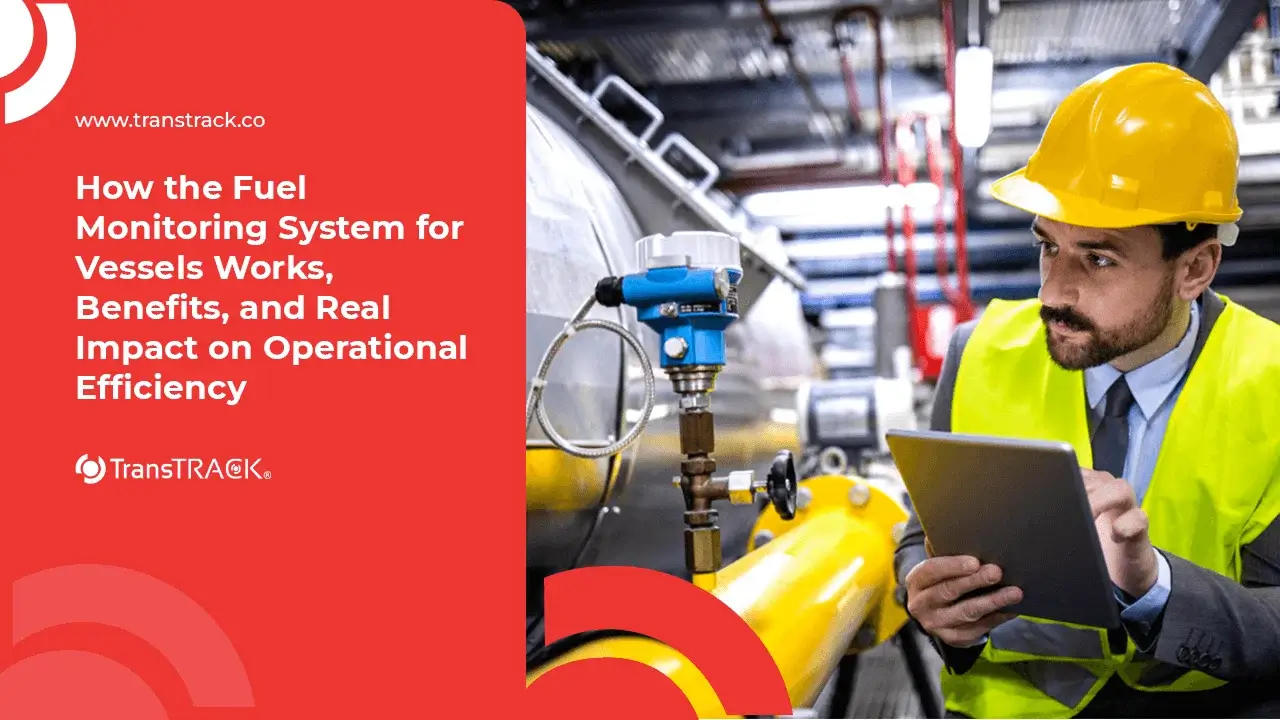How the Fuel Monitoring System for Vessels Works, Benefits, and Real Impact on Operational Efficiency
Posted on November 17, 2025 by Nur Wachda Mihmidati

The use of a Vessel Fuel Monitoring System has become an essential need for the shipping industry to improve fuel efficiency and reduce operational costs. This system can provide full visibility of ship fuel consumption through real-time data and accurate analytics. This TransTRACK article will discuss the functions, how it works, benefits, and reasons why a Vessel Fuel Monitoring System is the best solution for improving the performance of modern sea fleets.
What is a Fuel Monitoring System on a Ship?
A Vessel Fuel Monitoring System is a monitoring system installed on ships to measure, record, and analyze fuel consumption in real-time. This system operates using sensors installed in fuel tanks, pipes, and ship engines to ensure fuel usage data is accurately recorded while the ship is in operation. With a Vessel Fuel Monitoring System, shipping companies can control fuel usage, reduce waste, improve route efficiency, and lower operational costs.
Impact of Fuel Monitoring System on Operational Efficiency
Vessel Fuel Monitoring System technology can transform how companies manage fuel operations. With the right system, ship managers can reduce operational costs and improve fleet reliability. Here are the main impacts of using a Vessel Fuel Monitoring System in operations:
Real-time tracking of fuel consumption per ship or per route
- Provides live and real-time monitoring of fuel usage.
- Makes it easy to compare fuel consumption between routes to determine the most efficient route.
- Minimizes the potential for undetected fuel consumption deviations.
Analytical data for decision making (e.g. route optimization, docking schedules)
- Providing data-driven insights for captains and operations.
- Used to determine the ideal docking time based on consumption patterns.
- Helps plan routes that save costs and time.
Reduction of fuel waste by up to 20–30%
- Identify areas of overuse that can be immediately corrected.
- Reduce operational costs in the long term.
- Ensures more controlled and efficient fuel consumption.
How the Fuel Monitoring System Works on Ships
To understand the performance of a Vessel Fuel Monitoring System, it is important to see how data is generated and processed. This system relies heavily on sensors and digital integration to deliver accurate results. Here is a simple technical explanation of the workflow of a Vessel Fuel Monitoring System:
Measurement flow: from tank → sensor → data log → real-time dashboard
- Measurement starts from the flowmeter sensor and tank level.
- Data is collected in a data logger to ensure nothing is lost.
- Information appears on a live dashboard for quick monitoring.
Integration with navigation and engine monitoring systems
- The system is directly connected to the ship’s navigation to read the voyage conditions.
- Captures RPM data, speed over ground, and engine load.
- Provides a complete picture of the ship’s energy consumption.
Data visualization example (consumption graph per trip)
- Displays daily charts down to per route for in-depth analysis.
- Makes it easier for operators to see wasteful patterns on the go.
- Accelerate the evaluation of ship and captain performance.
Conclusion
Fuel monitoring systems for vessels help improve fuel efficiency, transparency, and operational accuracy. This technology can significantly impact ship costs and performance. With proper implementation, fuel monitoring systems for vessels are a crucial solution for modern fleet management.
Optimize your marine fleet operations with TransTRACK’s Vessel Monitoring System. Monitor your vessel’s fuel usage in real time, increase efficiency, and minimize risk on every voyage. Start improving your fleet control now with TransTRACK!

FAQ
How does a fuel monitoring system help the operational efficiency of ships?
This system helps improve ship operational efficiency by providing accurate data on fuel usage, helping reduce fuel waste during voyages, and improving route and engine operational efficiency.
Can the fuel monitoring system be integrated with fleet management?
Yes, most systems support full integration. Existing fuel data can be combined with GPS, engine, and fleet activity data. This makes it easier to control the fleet on a single integrated platform.
How much does it cost to install a fuel monitoring system on a shop?
Installation costs vary depending on the number of sensors, ship type, and integration features. The average investment is recouped through fuel savings in operations. Of course, installation prices can also be consulted with professional system providers.
What are the business benefits of implementing a fuel monitoring system?
The benefits include significant reduction in operational costs, accurate data for audits and compliance, and improved engine performance and equipment lifespan due to advanced systems that ensure overall fleet condition.
How to choose the best fuel monitoring system vendor for marine vessels?
Choose a vendor that provides full integration and a real-time dashboard. Then, ensure after-sales support and accurate sensor calibration. It is recommended to consider vendors with a strong track record of Vessel Fuel Monitoring System implementations.
Recent Post
What Causes GPS Tracker Offline and How to Fix It?
November 26, 2025Excavator Indicator Panel Symbols and Their Functions!
November 25, 2025Gas Coming Out of The Carburetor, See How to Fix It!
November 24, 2025Topic :
 Bahasa Indonesia
Bahasa Indonesia







